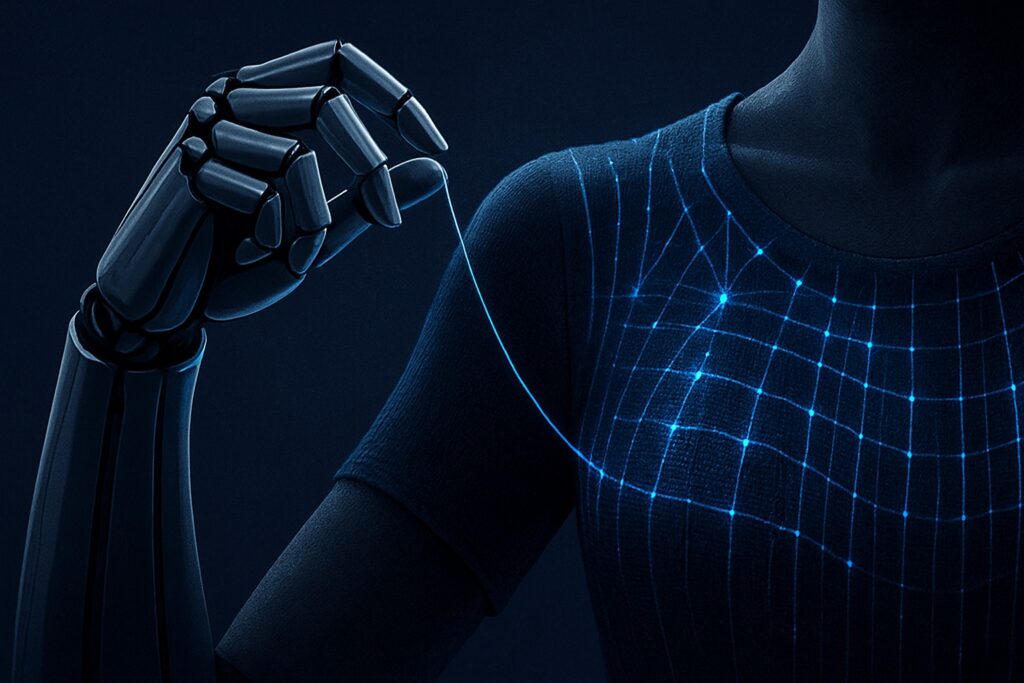
Imagine a world where your clothing does more than just cover your body — it actively monitors your health, adapts to the weather, and even changes its style on demand. This is the promise of Smart Textiles (or e-Textiles), a revolutionary field at the intersection of material science, electronics, and design. By seamlessly embedding tiny electronic components like conductive threads, optical fibres, and micro-sensors directly into fabric, we’re transforming passive garments into active, intelligent systems.
🔬 Beyond the Wearable: What Makes a Textile ‘Smart’?
A smart textile isn’t just clothing with a gadget attached; the technology is inherently part of the fabric’s structure. These textiles have three core functionalities:
- Sensing and Monitoring: Tiny sensors woven into the material can collect a wealth of data. Think shirts that track your heart rate, respiration, and body temperature with medical-grade accuracy, or socks that analyse your running gait and foot pressure.
- Actuation and Response: These fabrics can react to stimuli — textiles that can heat or cool themselves based on ambient temperature or the wearer’s body heat, or even change color (thermochromic or photochromic textiles) for fashion or camouflage.
- Power Generation and Storage: Researchers are developing fabrics that can harvest energy from body movement (piezoelectricity) or sunlight (fibre-based solar cells), potentially eliminating the need for bulky batteries.
⚕️ Key Applications Driving the Revolution
The practical applications for smart textiles span far beyond the catwalk, promising significant breakthroughs in critical sectors:
- Personalized Healthcare and Wellness: E-textiles are the future of non-intrusive, continuous health monitoring. Imagine a baby’s blanket that tracks their vitals or a garment that monitors the progress of rehabilitation at home. This shift towards real-time, pervasive data collection is essential for preventative and personalized medicine, especially for the elderly or those with chronic conditions.
- High Fashion and Design: Designers are embracing responsive fabrics to create dynamic, interactive apparel. Color-changing dresses, light-emitting garments, and clothes that self-adjust their fit offer entirely new possibilities for self-expression and aesthetics.
- Sports and Fitness: Smart textiles are revolutionizing athletic wear. In 2025, Adidas introduced smart training apparel equipped with pressure-sensitive fabrics that monitor stride, posture, and body movement in real time. This innovation provides athletes with precise biomechanical feedback, enhancing performance and reducing injury risks — proving how technology and fashion can merge seamlessly to create next-generation sportswear.
- Safety and Military: Uniforms can be integrated with sensors to monitor a soldier’s physical condition, detect exposure to hazardous chemicals, or even create adaptive camouflage that changes color to match the environment.
🚧 The Roadblocks: Washability and Sustainability
Despite the dazzling potential, smart textiles face major hurdles before they can fully integrate into daily life. The biggest challenges revolve around durability and end-of-life management:
| Challenge | The Core Problem | Innovative Solutions |
| Durability & Washability | Electronic components and conductive inks are vulnerable to mechanical stress (bending, twisting) and chemical damage from water and detergent. | Robust Encapsulation (protective layers to shield electronics), Self-Healing Materials (fabrics that automatically repair small tears or conductive cracks). |
| Sustainability & Waste | Combining textiles with metal-based electronics creates complex e-waste that is difficult to recycle or biodegrade. | Use of Biodegradable Materials (e.g., Tencel base fabric), Eco-Friendly Conductors (e.g., graphene-based inks), and Inkjet Printing (minimizing material waste). |
Recent breakthroughs, such as the development of fully biodegradable e-textiles that use eco-friendly components like graphene and wood-derived Tencel, are paving the way for a more sustainable future for smart clothing.
🔮 The Seamless Future
Smart textiles are poised to make traditional wearable gadgets obsolete by making the functionality truly invisible and inherent. As research solves the challenges of washability and sustainability, we are moving toward a future where our clothing will be our most personal, comfortable, and intuitive interface with the digital world.
The clothes we wear will no longer be a static layer, but a living, responsive part of our ecosystem — merging fashion, technology, and innovation into one intelligent fabric of the future.
